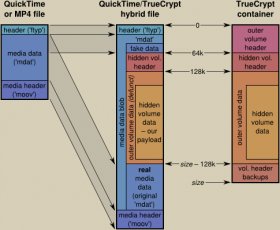Bitcoin QT 0.9.5
You probably know TrueCrypt,the perhaps most popular tool for encrypting filesystems. As an alternative to full filesystem or even full disk encryption,TrueCrypt can also work with filesystems inside encrypted container files. These are files that look like they’re full of purely random data,but when provided the correct decryption key,they reveal their true contents: A FAT or NTFS filesystem full of your secret data.
In addition to this basic functionality,TrueCrypt also offers a simple form of steganography. For the uninformed,steganography is the term for techniques that conceal the existence of secret data. This means that the secret information is hidden inside another unsuspicious piece of data. TrueCrypt does support this with its »hidden volume« feature. If this is used,a container can be opened with two different keys: The first not-so-secret key opens the »outer volume« with not-so-secret data and a second really secret key opens the hidden volume with the real secrets. There are two problems with this approach,though: First,it’s very simple to destroy the hidden volume since it’s embedded in the outer volume’s data area without proper marking in the outer volume filesystem’s meta-data (otherwise they would give away the presence of the hidden volume). This means that you can overwrite the hidden volume just by putting enough files inside the outer volume. TrueCrypt can protect the hidden volume when mounting the outer volume,but for this to work,you need to provide the hidden volume’s key.
The second issue with TrueCrypt’s approach to steganography is that TrueCrypt container files are just large files with random data and as such,they’re easily detectable. You can disguise them by giving them unsuspicious filenames – 






